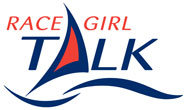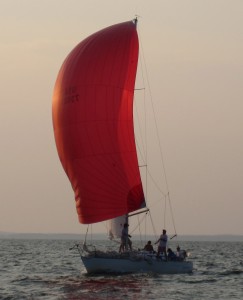You’re Putting WHO on Foredeck?
I’ve raced sailboats for over six years now. However, my time is typically spent in pit and trimming jib or guy. I was taught how to do foredeck a long time ago when I took a J World class on a J-80. Yet, I haven’t really done foredeck in a racing situation.
Tonight, I got to the boat (J-24) and realized that our usual foredeck person was not able to make the race. I totally believe that everyone on the boat should know how to perform all of the roles. It helps you better understand what team members need in each role. It also helps you be better prepared to jump in and help out if the necessity arises.
Wind tonight was about five knots, give or take — which didn’t seem too overwhelming. So, when I had the opportunity to do foredeck during the race; I took it. The other three crew members were incredibly patient and helpful. They talked me through some practice and then the race itself. This was especially kind since I don’t have much balance and I can be pretty clumsy and awkward (especially when my lack of coordination is on full display for my crew and other crews nearby to be entertained). So….if I can try foredeck, so can you!
Here are some of the things I learned tonight:
- Foredeck can look and feel like a comedy of errors…especially if you haven’t spent a lot of time there recently (but you can still get the job done — even if it isn’t really pretty).
- When rounding the windward mark, put the pole up, kite up, and jib down. On the J-24, I had to connect the topping lift to the pole and the pole to the mast when the pole went up.
- At the leeward mark, the goal was to put the jib up, drop the kite, and drop the pole (don’t forget the topping lift).
- Gybing seems like it happens in slow motion with wind like we had tonight (sometimes it was a lot less than 5 knots). It’s amazing how much you don’t hear (or can block out — intentionally or unintentionally) when crew members are yelling advice from the cockpit.
- It was helpful to move the jib clew forward so that I had a place to stand for spinnaker gybes.
- Pushing the pole forward on the guy helped me get the aft end made to the mast on the gybes.
- Put the lazy jib sheet over the pole when you have the pole back on deck. Otherwise, the sheets will get hung up and you won’t be able to tack,
- I am capable of focusing totally on fixing the pole. So much that I could (for example) miss a call to tack. That could result in me feeling like a beetle laying on my back on the deck with my feel up in the air (for example) — but we got the tack AND the pole stayed on the boat.
- The pole can be passed down the rail to put the guy in the jaws or to be ready to connect the topping lift.
- Did I mention that the lazy jib sheet needs to be over the pole with the halyard out of the way? Otherwise, you can create macrame with the lines around the pole, and you won’t be able to tack.
Overall, I think it was a great night to try my hand at foredeck — even if I was nervous. If I never get out there, my skills won’t get better. I encourage you to try something new too. It’s amazing how much stuff you think you know (in theory) because you watch someone else do it. It’s a lot different to put it in action yourself. Good Luck & Have Fun!!!


